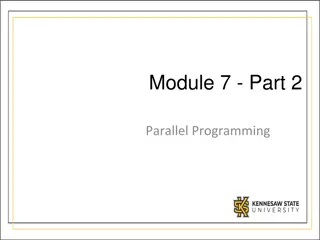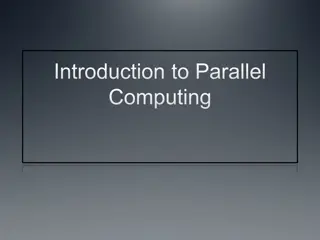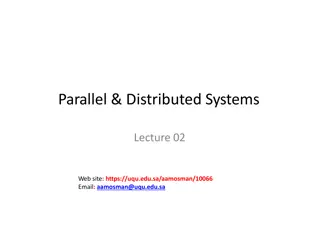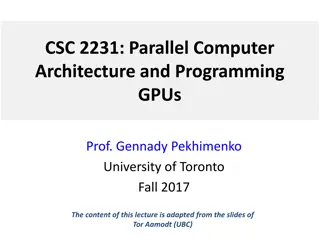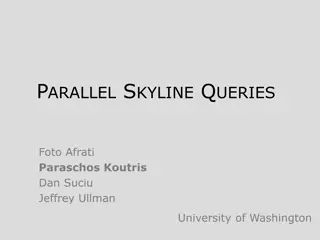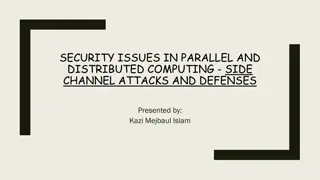Understanding Parallel and Distributed Computing Systems
In parallel computing, processing elements collaborate to solve problems, while distributed systems appear as a single coherent system to users, made up of independent computers. Contemporary computing systems like mobile devices, IoT devices, and high-end gaming computers incorporate parallel and distributed elements. The physical limits of sequential programs due to CPU clock frequency highlight the need for parallelism to enhance performance. Overcoming limitations like clock frequency and power density involve leveraging multiple computing elements in modern systems. Programming for parallel and distributed applications requires a different approach compared to traditional sequential programs, emphasizing task partitioning and communication among computing threads.
Download Presentation

Please find below an Image/Link to download the presentation.
The content on the website is provided AS IS for your information and personal use only. It may not be sold, licensed, or shared on other websites without obtaining consent from the author. Download presentation by click this link. If you encounter any issues during the download, it is possible that the publisher has removed the file from their server.
E N D
Presentation Transcript
Parallel and Distributed Systems What is a parallel computer? oA collection of processing elements that communicate and coorperate to solve problems. What is a distributed system? oA collection of independent computers that appear to its users as a single coherent system.
Almost all Contemporary Computing Systems are Parallel and Distributed Systems. o Mobile devices, IoT devices, many have multi-core CPUs IPhone 13, A15 6 CPU cores, 16 Neural Engine cores, 4 GPU cores o Desktop or laptop, multi-core CPU o A high-end gaming computer (CPU + GPU) o Multi-core server o Linprog cluster o Cloud Computing platforms (Amazon AWS, Google cloud). o Massive gaming platforms o Internet of Things o Fugaku supercomputer (No. 1 on November 11, 2021, 442 Peta flops peak performance) Uniprocessor systems Multi-processor systems
The performance limit of sequential program The CPU clock frequency implicitly implies how many operations the computer can perform for a sequential (or single-thread) program. oFor more than 10 years, the highest CPU clock frequency stays around 4GHz oFor a sequential (single thread) program, the time to perform 109 operations is in the order of seconds! See program/lect1/lect1_seq.cpp This is a physical limit: the CPU clock frequency is limited by the size of the CPU and the speed of light.
The limit of clock frequency Speed of light = 3 108m/s 4 109 s = 1 1 4 10 9s One cycle at 4Ghz frequency = The distance that the light can move at one cycle: 1 4 10 9s = 0.75 10 1m = 7.5cm o????? ???? = 3 108m/s Intel chip dimension = 1.47 in x 1.47 in = 3.73cm x 3.73cm Not much room left for increasing the frequency!
Another physical limit: power One may think of reducing the size of the CPU to increase frequency. Increasing CPU frequency also increases CPU power density. We switch to multi-core in the 2004 due to these physical limits. For a sequential (single thread) program, the time to perform 109 operations is in the order of seconds. o If one need more performance, making use of parallelism implicitly or explicitly in the hardware is the only way to go.
Using the Multiple Computing Elements in Contemporary Computing Systems In many cases, they support concurrent applications (multiple independent apps running at the same time). They can also support individual parallel/distributed applications by pulling more computing resources for one application. This will require a different type of programming than the conventional sequential programs. o Partition the task among multiple computing threads, coordinating and communicating among computing threads This course will look under the hood of such systems and examine their architectures, how to write effective programs to exploit architectural features, and issues and solutions at different levels to enable parallel and distributed computing.
Programming Parallel and Distributed Systems Two focuses of programming paradigms for PDS: o Productivity Computing systems are fast enough for most applications. Coding is often where the bottleneck and cost are. Many programming systems is designed for productivity. For example, Python, Matlab, etc. o Performance Computing systems are not fast enough for some applications (e.g. the training of very large deep learning models). As a result, performance is also a focus. Programming systems in practice all claim to support both productivity and performance. As computing systems become more heterogeneous and complicated, the balance between the two is still under heavy investigation at this time. This class focuses on performance.
Why parallel/distributed computing? Some large scale applications can use any amount of computing power. o Scientific computing applications Weather simulation. More computing power means more finer granularity and prediction longer into the future. Japan s K machine was built to provide enough computing power to better understand the inner workings of the brain. o Training of large machine learning models in many domains. In small scale, we would like our programs to run faster as the technology advances conventional sequential programs are not going to do that.
Why parallel/distributed computing? Bigger: Solving larger problems in the same amount of time. Faster: Solving the same sized problem in a shorter time.
More about parallel/distributed computing Parallel/distributed computing allows more hardware resources to be utilized for a single problem. Parallel/distributed programs, however, do not always solve bigger problems or solve the same sized problems faster. Exploiting parallelism introduces overheads: work that is not necessary in the sequential program. Not all applications have enough parallelism. Na ve parallel programs are easy to write, but may not give you what you want.
What we will do in this class? Examine architectural features of PDS Introduce how to exploit the features and write efficient code for PDS o Sequential code is a fundamental part of parallel code, so we will briefly discuss how to write efficient sequential code. Study systems issues PDS and their programming are very broad, we try to achieve a balance between breadth and depth.


